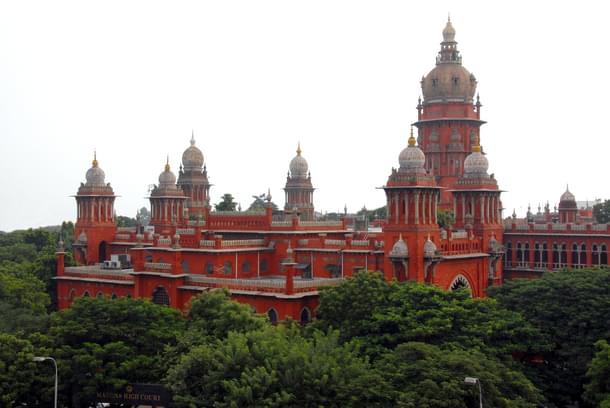Politics
How The Old Media Distorts Important Court Judgments
Shreya Agarwal
Feb 03, 2016, 11:01 PM | Updated Feb 10, 2016, 04:47 PM IST
Save & read from anywhere!
Bookmark stories for easy access on any device or the Swarajya app.


Here are three important judgments, delivered by the higher Courts of the country, which were unfairly reported by the media.
The popular Roman saying ‘Law is codified common sense’ elevates common sense to the level of law itself. The keyword here: codified. Another quote by Voltaire, points out that “…common sense is not so common”. Read the former in light of the latter, and imagine what happens to our basic understanding of law, in general, and the law of the land in particular, when we read poorly re-interpreted and sensationalised versions of Court judgments in various media reports.
We shall look into three such irresponsibly reported judgments, delivered by the higher Courts of the country, which at times were lauded unnecessarily, and on other occasions criticised unfairly by the media. In either case, the reports altered the masses’ perception of the higher judiciary, and of the prevailing laws of the country.
The first case relates to a judgment passed by the Apex Court on 8 April, 2015, which was wrongly perceived to declare that a “Couple living together will be presumed married” by a Times of India report dated 13 April, 2015.
It was held here that a certain Phoolbasa Bai’s heirs were eligible to get a share in the property of a man named Chhatrapati, although Phoolbasa was not legally wedded to him. The facts showed that the two had lived in a joint family projecting themselves as spouses to the society until Chhatrapati’s demise.
The challenge, therefore, by Phoolbasa’s sister-in-law’s grandson to the shares of her heirs in Chhatrapati’s property was struck down. Law permits inheritance of a man’s property to his wife only. But the uniqueness of the situation demanded that Phoolbasa be deemed as Chhatrapati’s wife by law.
This should not have been confused as a generalized statement by the Court declaring a blanket protection of the marital status to all live-in relationships. Unfortunately, it was confused as the same by many articles including one in HuffPost India.
Another attention-grabbing judgment which was on the receiving end of unbridled criticism was delivered by the Madras High Court, where the Court supposedly declared that “Couples who have premarital sex will be considered married.” This is according to a report of the same name, dated 22 June, 2013 published in The Hindu. A furore resulted in the public about this ‘regressive’ judgment following such misplaced newspaper reports.
The judgment of Aysha v Ozir Hassan delivered by Justice Karnan, ‘outraged’ the collective conscience of the society at large as the Court permitted maintenance to be paid to a Muslim woman aged about 35 years of age and her two daughters born through Hassan.
Hassan, here, represented himself as the father of the second daughter as per relevant hospital records. The couple had lived together as a married couple in Coimbatore for all practical purposes. However they had not undergone the required Muslim customs, and that argument was the fulcrum around which Hassan’s case revolved.
Considering the situation on the fact that documentary evidence existed to prove that Hassan had represented himself, as Aysha’s lawful husband on several occasions, the Court ordered for maintenance to be paid to the women and the daughters. The operative part of the judgment was the following:
Both of them led their marital life under the same shelter and begot two children. Therefore, the petitioner’s rank has been elevated as the ‘wife’ of the respondent and likewise the respondent’s rank had been elevated as the ‘husband’ of the petitioner. Therefore, the children born to them are ‘legitimate’ children and the petitioner is the ‘legitimate’ wife of the respondent.
There were other parts in the judgment which the Judge used as obiter dictum , to substantiate his point. However these did not form part of the ratio decidendi and should not have been portrayed as such. The latter, forms that part of the judgment which is binding and can be cited as a precedent, while the former implies a remark in a judgment that is said in passing by the judge which is non-binding. Most reporters overlook this part while reporting the judgments.
The judge, in the process of coming out in support of civil law rights of women, ends up damaging the Muslim personal law requirements of a valid marriage and opines that-
…the marriage formalities as per respective religious customs viz., tying of thali, exchange of garlands, exchanging of finger rings, circling around the matrimonial fire pit or registering of marriage at a Government Registration Office is only to comply with each one’s respective religious customs for the satisfaction of the society. However, if any couple, subject to their attaining the mandatory age of freedom, who indulge in sexual gratification, then that would be considered as valid marriage and they could be termed as “husband and wife”, as a result of their choice of freedom….
Important to keep in mind the simple word ‘could’. Grammar lessons and common sense acquired over the years would remind us how much damage simple words can result in. The stated judgement implied that legal sanction to the marriage does not depend on the fulfilment of the rituals required by any religion alone. If circumstances on hand indicate that a marital relationship or a ‘relationship in the nature of marriage’ has existed earlier between two parties, they could legally be termed ‘husband’ and ‘wife’- but this terming is not mandatory .
Moreover, the judgment must be read in light of the specific scenario where consummation between the couple was proved and documentary evidence proved Ozir admitting to be Aysha’s wife. Legally speaking, consummation has always been a factor for determining the existence of a marriage, so Justice Karnan’s emphasis on consummation as one of the factors to judge whether a relationship in the nature of marriage existed or not seems perfectly logical.
However, opinions on sexual freedom sell better than hot-cakes these days. Merrily cooking up a controversy where one did not exist at all, the reporters came up with headlines like “Couples who have premarital sex to be considered married.”
Some even angrily ranted about how the judgment compromised the sexual freedom of women, ‘polarising’ them. The author here picks up random sentences from the judgment and ends up revealing his poor comprehension of both law and grammar. A judgment needs to be read as a whole and cannot be dissected and portrayed through isolated parts as something totally different than what it intended. This is a basic principle of legal interpretation. The reporters cannot afford to indulge in the malpractice of writing pieces that sell but misinform. This goes against the very ethics of journalism.
The case of Vishwa Lochan Madan v UOI was another one where the reporters went on a spree of publishing articles getting people to believe that Shariat Courts and fatwas were declared illegal by the Supreme Court.
In the judgment while the Court did say that fatwas did not have legal backing and cannot be forcefully imposed on those not seeking them, this did not amount to saying that fatwas or Sharia Courts are illegal and cannot be enforced. The Court stated that:
A Fatwa is an opinion, only an expert is expected to give. It is not a decree, not binding on the court or the State or the individual. It is not sanctioned under our constitutional scheme. But this does not mean that existence of Dar-ul-Qaza or for that matter practice of issuing Fatwas are themselves illegal. It is informal justice delivery system with an objective of bringing about amicable settlement between the parties. It is within the discretion of the persons concerned either to accept, ignore or reject it.
This again was a befitting example of the print media misleading their readers.
The Constitution not only grants but actively protects our freedom to speech and expression. The media, however, while reporting should remember that the same Constitution also guarantees and protects the right to information- a provision which upholds the right to be informed- thereby imposing a corresponding duty on the media to not misinform us.
A recent Himachal Pradesh High Court decision made it clear that answers will be demanded from the reporters for the reports they publish in the name of the Court. The High Court of Himachal Pradesh issued contempt proceedings against a reporter for sensationalized legal reporting where it stated-
This is mis-reporting, without going through the orders passed by this Court from time to time. The news-item is inaccurate, unauthentic and not based on true facts. It reminds the Court of the grim erstwhile era of ‘Yellow Journalism….
The importance of responsible legal journalism was recognized and more importantly acted upon by the judiciary, for perhaps the first time through this judgment.
The Court with every decision it takes walks a tight-rope with the objective law, on one side, and the subjective situation demanding fairness on the other. There is no straitjacket formula or definition of justice.
The achievement is in getting as close to ‘justice’ as possible. To facilitate the carrying out of this onerous task, the courts are given judicial discretion, i.e. the power to interpret the law as it stands, and see if and how it applies to the case at hand.
Every judgment, therefore, ends up being unique in its interpretation and application of the law. This uniqueness needs to be captured in any report and is often overlooked. Decoding codified common sense is clearly not a mean task, and must be carried out with attention to detail.
Student of Law at NLU - Orissa.





